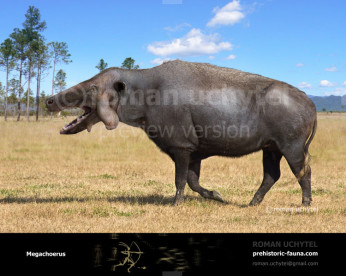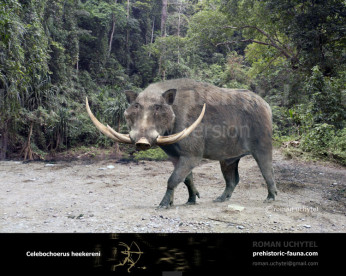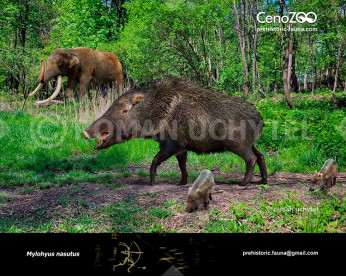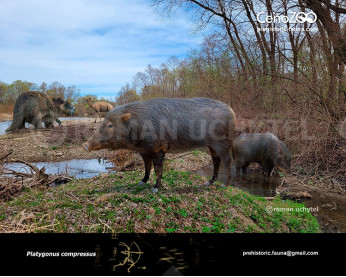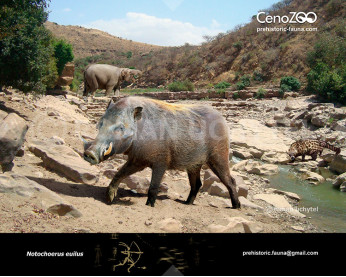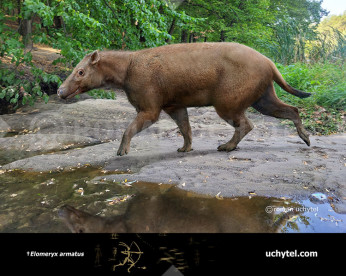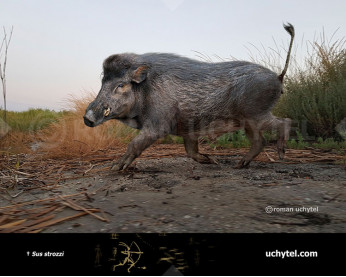Megalochoerus (†Megalochoerus (Pickford, 1993)
Order: Artiodactyla
Family: Suidae
Dimensions: length - 380 cm, height - 180-220 сm, weight ~1600 kg
Temporal range: Miocene of Africa and Arabia
A largest representative: Megalochoerus homungous
Megalochoerus is an extinct genus of large and long-legged animals in the pig family from the Miocene of Africa. The suid species Kubanochoerus khinzikebirus and K. marymuunguae are now assigned to Megalochoerus. The largest species - Megalochoerus homungous.
«The status of the huge genus Megalochoerus is a matter of debate (Van der Made, 1996a) – is it a valid genus?, is it an anthracothere?, is it a suid? Better material is required to settle the questions, but the presence of a huge suid in the Middle Miocene deposits of the Indian Subcontinent (Bugti, Manchar) is acknowledged by all who are participating in the debate. Van der Made (1996a) for example, called the species Kubanochoerus mancharensis and he accepted that some of the material included in Megalochoerus by Pickford (1993) belongs to Suidae.»
«In this context, the classification of Van der Made is understandable, but there remains some doubt about his interpretation of the holotype mandible of Megalochoerus homungous as possessing anthracotherian affinities. Pending the recovery of more informative material, the question of the familial affinities of Megalochoerus is held in abeyance."
«Pickford (1987) assigned the kubanochoere molar from Bugti as well as several other specimens from Bugti to Hemimastodoncrepusculi, in his opinion a suid related to Kubanochoerus. The affinities of this monospecific genus have often been discussed, proboscidean or suid. The species is based on an NT and besides there is a similar M" which both are maintained in the Proboscidea by Tassy (1988). Tassy's arguments in favour of proboscidean affinities seem to be valid. Two of the arguments used by Tassy are of particular interest and are rephrased and extended here. Kubanochoerus has well-developed protopreconules and tetrapreconules. These are not visible as individual structures in Hemimastodon (but are 'V-shaped' lophs). No species of Kubanochoerus shows a tendency to develop longer M 3 ; no large hexacones are found. Besides, it can be argued that the two Hemimastodon M'1 seem too large for the rest of the hypodigm, as given by Pickford».
«The second description of fossil kubanochoeres was by Forster-Cooper (1924) but he attributed the fossils from Bugti, Baluchistan (Pakistan) to Anthracotheriidae, mainly on account of their gigantic size (Pickford, 1987c, 1993). One of the specimens is listed as a co-type of Anthracotherium ingens, but this species was declared to be a synonym of Anthracotherium bugtiense Pilgrim, 1907, by Pickford (1987c) a fact that meant a new species name was required. It was eventully named Megalochoerus homungous Pickford, 1993.
Pickford (1987c) re-examined the suiforms from Bugti, described originally by Pilgrim (1908) and Forster-Cooper (1915, 1924) and recognised that several of the huge specimens belonged to suids rather than to anthracotheres. He also thought that the holotype of Hemimastodon crepusculi from Bugti, described by Pilgrim (1908) belonged to the same group, but subsequent study (Pickford, 1993) revealed that Hemimastodon was indeed a proboscidean, which left the giant suids from Bugti without a name, which is why Pickford (1993) erected the new genus and species Megalochoerus homungous for them.
Van der Made (1996a) considered that Megalochoerus homungous Pickford (1993) was based on a mixture of anthracotheres (Bugti material including the type specimen) and suids (Nyakach fossils). He erected the species Kubanochoerus mancharensis for a right talus and other post-cranial elements, and attributed several teeth to it : a lower molar from Bugti (NHMUK M 12700, Pickford, 1987, pl. 2, fig. 3, at the time recognised as a suid, but erroneously attributed to Hemimastodon) and an upper molar from Inönü, Turkey (AKI-3/779, Pickford & Erturk, 1979, fig. 4) and fossils from Maboko and Majiwa, Kenya. However, the Maboko and Majiwa fossils have the same dimensions as Kubwachoerus khinzikebirus, and are appreciably smaller than specimens of Kubwachoerus nyakachensis and Megalochoerus homungous (and Kubanochoerus mancharensis).
The three species attributed to the new genus, Kubwachoerus, were previously attributed to Megalochoerus Pickford, 1993. Van der Made (1996a) however, wrote that, with the exception of one fossil from Bugti and one from Nyakach, the hypodigm of Megalochoerus homungous belongs to anthracotheres.
Comparisons soon revealed that the fossil represented a huge suid (Pickford, 1993) and it was eventually included in the hypodigm of Megalochoerus homungous a vast suiform from Bugti, Pakistan. Van der Made (1996a) considered that the holotype and most of the hypodigm of Megalochoerus homungous belonged to anthracotheres, but he recognised that a lower molar in a fragment of mandible from Bugti and the Nyakach fossils were genuinely suid. He created the species Kubanochoerus mancharensis for this huge suid, nominating a talus from Manchar, Pakistan, as holotype, and attributing the Nyakach fossils to it.
In this context, the classification of Van der Made is understandable, but there remains some doubt about his interpretation of the holotype mandible of Megalochoerus homungous as possessing anthracotherian affinities. Pending the recovery of more informative material, the question of the familial affinities of Megalochoerus is held in abeyance.
The status of the huge genus Megalochoerus is a matter of debate (Van der Made, 1996a) – is it a valid genus?, is it an anthracothere?, is it a suid? Better material is required to settle the questions, but the presence of a huge suid in the Middle Miocene deposits of the Indian Subcontinent (Bugti, Manchar) is acknowledged by all who are participating in the debate. Van der Made (1996a) for example, called the species Kubanochoerus mancharensis and he accepted that some of the material included in Megalochoerus by Pickford (1993) belongs to Suidae».
You may use multiple payment methods to buy image such as credit cards, PayPal and bank transfer.

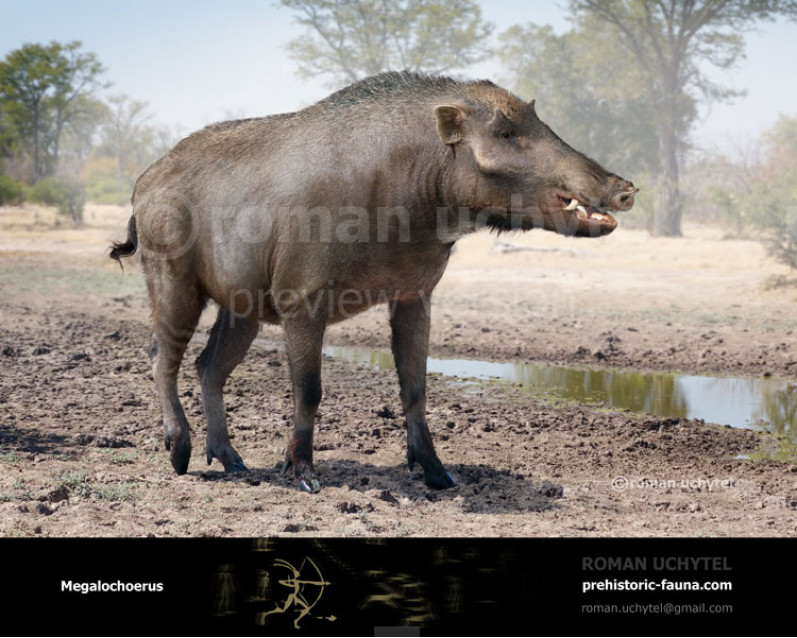
-797x638.jpg)
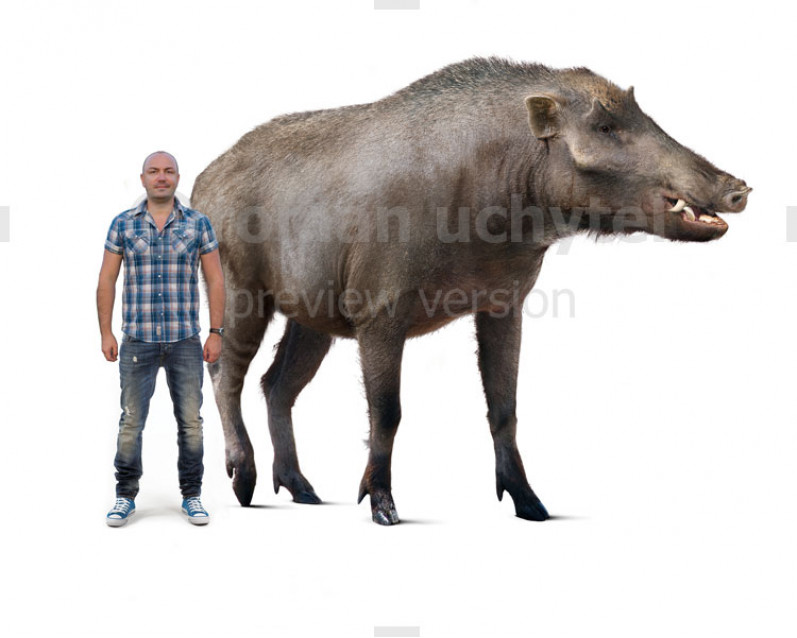

-70x56.jpg)

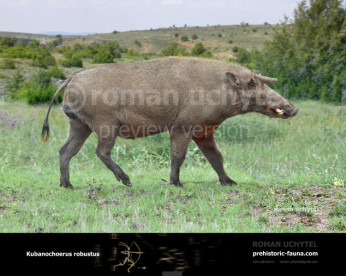
-346x277.jpg)
